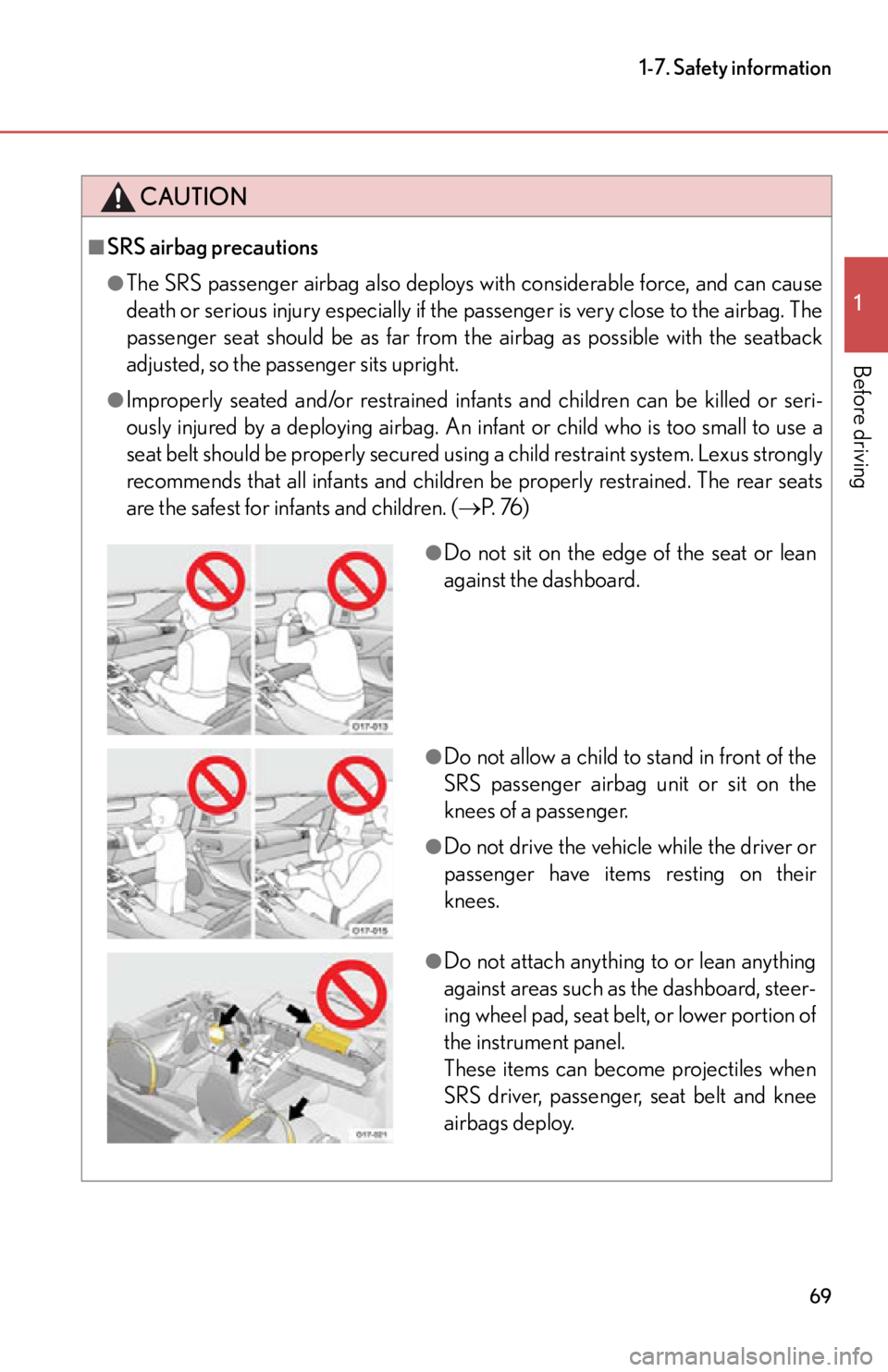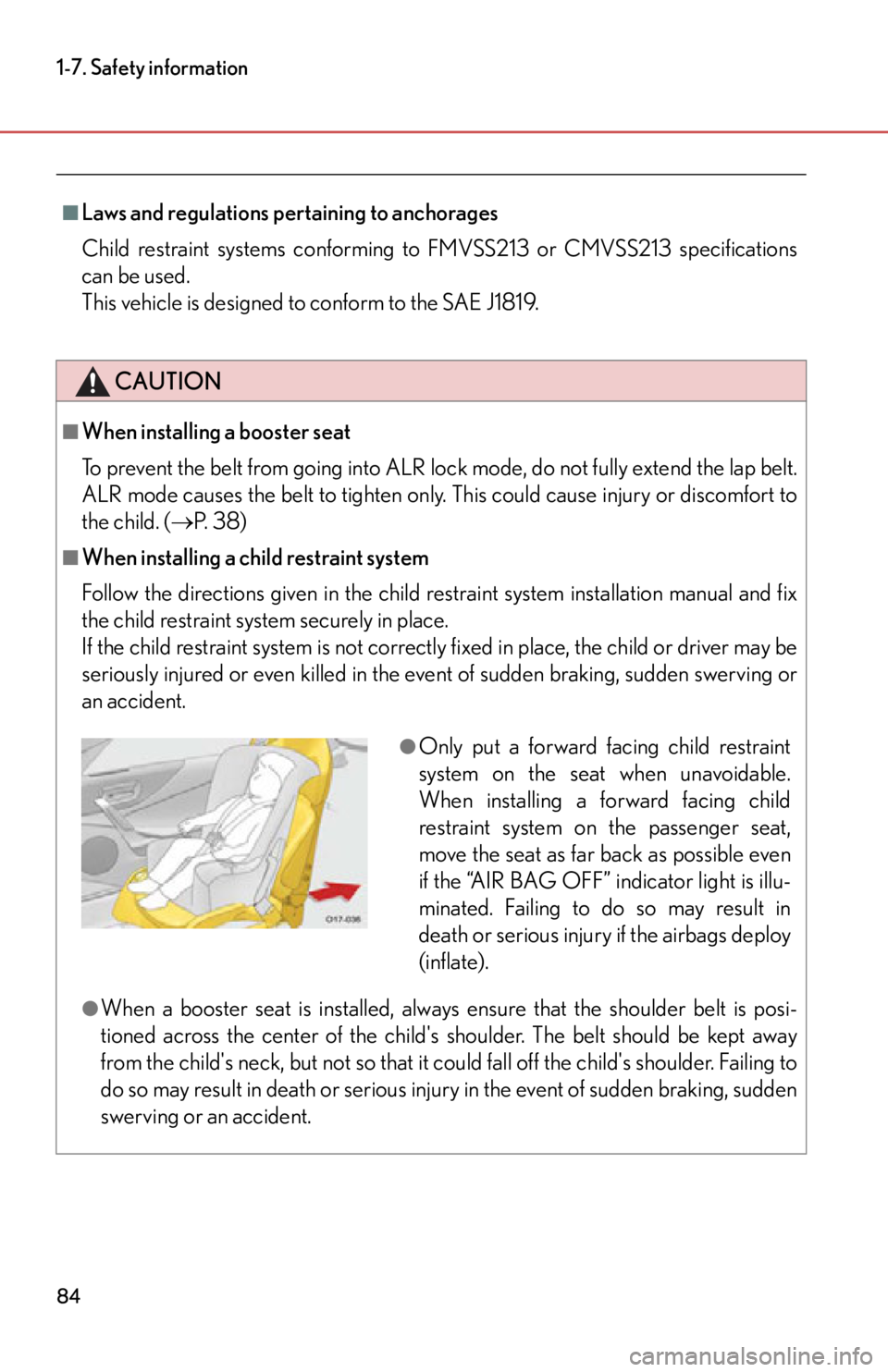Page 70 of 420

68
1-7. Safety information
CAUTION
■SRS airbag precautions
Observe the following precautions regarding the airbags.
Failure to do so may cause death or serious injury.
●The driver and passenger in the vehicle must wear their seat belts properly.
The SRS airbags are supplemental devices to be used with the seat belts.
●The SRS driver airbag deploys with considerable force, and can cause death or
serious injury especially if the driver is very close to the airbag. The National
Highway Traffic Safety Administration (“NHTSA”) advises:
Since the risk zone for the driver airbag is the first 2 - 3 in. (50 - 75 mm) of infla-
tion, placing yourself 10 in. (250 mm) from your driver airbag provides you with a
clear margin of safety. This distance is measured from the center of the steering
wheel to your breastbone. If you sit less than 10 in. (250 mm) away now, you can
change your driving position in several ways:
• Move your seat to the rear as far as you can while still reaching the pedals
comfortably.
• Slightly recline the back of the seat. Although vehicle designs vary, many dr ivers can achieve the 10 in. (250 mm)
distance, even with the driver’s seat all the way forward, simply by reclining
the back of the seat somewhat. If reclining the back of your seat makes it hard
to see the road, raise yourself by using a firm, or raise the seat if your vehicle
has that feature.
• If your steering wheel is adjustable, ti lt it downward. This points the airbag
toward your chest instead of your head and neck.
The seat should be adjusted as recommended by NHTSA above, while still main-
taining control of the foot pedals, steering wheel, and your view of the instrument
panel controls.
Page 71 of 420

69
1-7. Safety information
1
Before driving
CAUTION
■SRS airbag precautions
●The SRS passenger airbag also deploys with considerable force, and can cause
death or serious injury especially if the passenger is very close to the airbag. The
passenger seat should be as far from the airbag as possible with the seatback
adjusted, so the passenger sits upright.
●Improperly seated and/or restrained infants and children can be killed or seri-
ously injured by a deploying airbag. An infant or child who is too small to use a
seat belt should be properly secured using a child restraint system. Lexus strongly
recommends that all infants and children be properly restrained. The rear seats
are the safest for infants and children. ( P. 76 )
●Do not sit on the edge of the seat or lean
against the dashboard.
●Do not allow a child to stand in front of the
SRS passenger airbag unit or sit on the
knees of a passenger.
●Do not drive the vehicle while the driver or
passenger have items resting on their
knees.
●Do not attach anything to or lean anything
against areas such as the dashboard, steer-
ing wheel pad, seat belt, or lower portion of
the instrument panel.
These items can become projectiles when
SRS driver, passenger, seat belt and knee
airbags deploy.
Page 72 of 420
70
1-7. Safety information
CAUTION
■SRS airbag precautions
●Wear the seat belt correctly.
●If a vinyl cover is put on the area where the SRS knee airbag will deploy, be sure to
remove it.
●Do not wrap seat belt covers or other such items around the area where the SRS
seat belt air bag will inflate.
●Do not strike or apply significant levels of force to the area of the SRS airbag
components shown on P. 63.
Doing so can cause the SRS airbags to malfunction.
●Do not touch any of the component parts immediately after the SRS airbags have
deployed (inflated) as they may be hot.
●If breathing becomes difficult after the SRS airbag has deployed, open a door or
window to allow fresh air in, or leave the vehicle if it is safe to do so. Wash off any
residue as soon as possible to prevent skin irritation.
●If the areas where the SRS airbags are stored, such as the steering wheel pad
and/or seat belt, are damaged or cracked, have them replaced by your Lexus
dealer.
Page 73 of 420
71
1-7. Safety information
1
Before driving
CAUTION
■Modification and disposal of SRS airbag system components
Do not dispose of your vehicle or perform any of the following modifications with-
out consulting your Lexus dealer.
The SRS airbags may malfunction or deploy (inflate) accidentally, causing death or
serious injury.
●Installation, removal, disassembly and repair of the SRS airbags.
●Repairs, modifications, removal or replace ment of the steering wheel, instrument
panel, dashboard or seat belt.
●Repairs or modifications of the front fender or front bumper.
●Installation of snow plows, winches, etc. to the front grille (bull bars, kangaroo bar
etc.).
●Modifications to the vehi cle's suspension system.
●Installation of electronic devices such as mobile two-way radios or CD players.
●Modifications to your vehicle for a person with a physical disability.
Page 75 of 420

73
1-7. Safety information
1
Before driving
Condition and operation in the passenger occupant classification system
■Adult*1
■Child *3 or child restraint system*4
■Unoccupied
Indicator/
warning light “AIR BAG ON” and “AIR BAG OFF”
indicator lights “A I R B A G
ON”
SRS warning light Off
Passenger’s seat belt reminder light Flashing
*2
DevicesPassenger airbag
Activated
Seat belt airbag on the passenger seat
Passenger’s seat belt pretensioner
Indicator/
warning light “AIR BAG ON” and “AIR BAG OFF”
indicator lights “A I R B A G
OFF”
*5
SRS warning light Off
Passenger’s seat belt reminder light Flashing
*2
DevicesPassenger airbag
Deactivated
Seat belt airbag on the passenger seat
Passenger’s seat belt pretensioner Activated
Indicator/
warning light “AIR BAG ON” and “AIR BAG OFF”
indicator lights
Not illuminated
SRS warning light Off
Passenger’s seat belt reminder light
Devices Passenger airbag
Deactivated
Seat belt airbag on the passenger seat
Passenger’s seat belt pretensioner
Page 76 of 420

74
1-7. Safety information
■There is a malfunction in the system
*
1: The system judges a person of adult size as an adult. When a smaller adult sits in the passenger seat, the system may recognize him/her as
a child depending on his/her physique and posture.
*
2: In the event the passenger does not wear a seat belt.
*
3: When a larger child who has outgrow n a child restraint system sits in
the passenger seat, the system may recognize him/her as an adult
depending on his/her physique or posture.
*
4: Never install a rear-facing child restraint system on the passenger
seat. If a child restraint system needs to be installed, install a forward
facing child restraint system on the passenger seat. ( P. 76 )
*
5: In case the indicator is not illumina ted, consult this manual on how to
install the child restraint system properly. ( P. 8 0 )
Indicator/
warning light “AIR BAG ON” and “AIR BAG OFF”
indicator lights “A I R B A G
OFF”
SRS warning light On
Passenger’s seat belt reminder light Off
Devices Passenger airbag
Deactivated
Seat belt airbag on the passenger seat
Passenger’s seat belt pretensioner Activated
Page 80 of 420

78
1-7. Safety information
CAUTION
■Child restraint precautions
●For effective protection in automobile accidents and sudden stops, a child must
be properly restrained, using a seat belt or child restraint system depending on
the age and size of the child. Holding a child in your arms is not a substitute for a
child restraint system. In an accident, th e child can be crushed against the wind-
shield, or between you and the vehicle's interior, causing death or serious injury.
●Never install a rear-facing child restraint system on the passenger seat even if the
“AIR BAG OFF” indicator light is illuminated. In the event of an accident, the force
of the rapid inflation of the passenger ai rbag can cause death or serious injury to
the child if the rear-facing child restraint system is installed on the passenger seat.
●A forward-facing child restraint system may be installed on the passenger seat
only when it is unavoidable. Adjust the seatback as upright as possible and always
move the seat as far back as possible even if the “AIR BAG OFF” indicator light is
illuminated, because the passenger airbag could inflate with considerable speed
and force. Otherwise, the child may be killed or seriously injured.
●Make sure you have complied with all inst allation instructions provided by the
child restraint manufacturer and that the sy stem is properly secured. If it is not
secured properly, it may cause death or seri ous injury to the child in the event of a
sudden stop, sudden swerve or an accident.
●When installing a child restraint system, do not add clips to the shoulder belt, as
doing so may prevent the seat belt airbags from operating properly.
●After using the child restraint system, check the vehicle's seat belt for any dam-
age. If the seat belt is damaged, have it replaced by any authorized Lexus dealer
or repairer, or another duly qualified and equipped professional.
Page 86 of 420

84
1-7. Safety information
■Laws and regulations pertaining to anchorages
Child restraint systems conforming to FMVSS213 or CMVSS213 specifications
can be used.
This vehicle is designed to conform to the SAE J1819.
CAUTION
■When installing a booster seat
To prevent the belt from going into ALR lo ck mode, do not fully extend the lap belt.
ALR mode causes the belt to tighten only. This could cause injury or discomfort to
the child. ( P. 3 8 )
■When installing a child restraint system
Follow the directions given in the child restraint system installation manual and fix
the child restraint system securely in place.
If the child restraint system is not correctl y fixed in place, the child or driver may be
seriously injured or even killed in the ev ent of sudden braking, sudden swerving or
an accident.
●When a booster seat is installed, always ensure that the shoulder belt is posi-
tioned across the center of the child's shoulder. The belt should be kept away
from the child's neck, but not so that it could fall off the child's shoulder. Failing to
do so may result in death or serious inju ry in the event of sudden braking, sudden
swerving or an accident.
●Only put a forward facing child restraint
system on the seat when unavoidable.
When installing a forward facing child
restraint system on the passenger seat,
move the seat as far back as possible even
if the “AIR BAG OFF” in dicator light is illu-
minated. Failing to do so may result in
death or serious injury if the airbags deploy
(inflate).